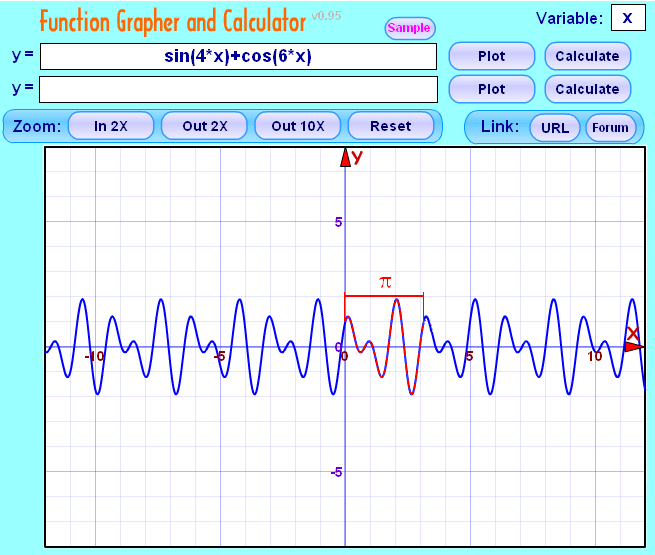Math Is Fun Forum
You are not logged in.
- Topics: Active | Unanswered
Pages: 1
#1 2007-04-02 03:34:50
- Prakash Panneer
- Member
- Registered: 2006-06-01
- Posts: 110
Periodic function
Find the period of the following functions
a)f(x) = sin 4x + cos 4x,
b)g(x) = |sin 4x| + |cos 4x|,
c)h(x) = sin 4x + cos 6x.
Thanks in Advance
Letter, number, arts and science
of living kinds, both are the eyes.
Offline
#2 2007-04-02 03:45:15
- Stanley_Marsh
- Member

- Registered: 2006-12-13
- Posts: 345
Re: Periodic function
The first one , since
The Period is
Last edited by Stanley_Marsh (2007-04-02 04:14:40)
Numbers are the essence of the Universe
Offline
#3 2007-04-02 04:07:17
- jagabandhu
- Member
- Registered: 2007-03-30
- Posts: 6
Re: Periodic function
see the definition of a periodic function is as below:
A function f(x) is periodic if f(x)=f(x+t) so that t is the period of the function f(x). Now the period of sin(x) and cos(x) can be determined by using the ASTC rule, where A means all, S means Sin, T means Tan and C means Cot positive in 1st, 2nd, 3rd and 4th quadrants. Accordingly the periods of Sin(x) and Cos(x) are 2(pi).
I think you can approach the problem by using this. Otherwise you can ask me again or e-mail me in my id writing the complete problem.
good luck.
Offline
#4 2007-04-02 09:47:54
- JaneFairfax
- Member

- Registered: 2007-02-23
- Posts: 6,868
Re: Periodic function
My conjecture is that if m and n are positive integers with greatest common divisor d, sin(mx)±cos(nx) has the same period as sin(dx) or cos(dx), namely 2π⁄d. If so then f(x) and h(x) should have periods 2π⁄4 = π⁄2 and 2π⁄2 = π respectively.
This is just a conjecture though. Im not totally sure if its right or not (though Im trying to figure out if its true or not). In any case, Ive plotted the graphs of these particular functions and they seem to agree with my conjecture. ![]()
For the second one, note that
Hence, g(x) = |sin(4x)+cos(4x)| for 0 ≤ x < π⁄8, g(x) = |sin(4x)−cos(4x)| for π⁄8 ≤ x < π⁄4, and the cycle repeats. ∴ its period is π⁄4.
Offline
#5 2007-04-02 12:29:01
- JaneFairfax
- Member

- Registered: 2007-02-23
- Posts: 6,868
Re: Periodic function
WAIT! I just plotted the graph of g(x) again and found that its period is actually π⁄8. I must have done something wrong above. ![]()
Ill sort it out and fix it.
Offline
#6 2007-04-02 13:21:40
- JaneFairfax
- Member

- Registered: 2007-02-23
- Posts: 6,868
Re: Periodic function
Ahahaha! Its actually simple enough!
is the exactly the same as
And
Hence the behaviour of g(x) is totally identical for 0 ≤ x < π⁄8 as for π⁄8 ≤ x < π⁄4. ∴ g(x) has a period of π⁄8 after all. ![]()
Offline
#7 2007-04-03 10:05:04
- JaneFairfax
- Member

- Registered: 2007-02-23
- Posts: 6,868
Re: Periodic function
Now I return to the claim I made earlier: if d = gcd(m,n) then sin(mx)±cos(nx) has period 2π⁄d. This is, of course, provided sin(mx)±cos(nx) ≢ 0. Well, to show that 2π⁄d is a periodicity value, we just replace x by x+2π⁄d and see what happens.
since m⁄d and n⁄d are both integers.
Moreover, since d is the largest integer that makes both m⁄d and n⁄d integers, it is clear that 2π⁄d is indeed the smallest periodicity value for sin(mx)±cos(nx). Well, I suppose that wraps it up. ![]()
Note that this also works for sin(mx)±sin(nx) and cos(mx)±cos(nx) (provided they are not identically 0).
Last edited by JaneFairfax (2007-04-03 10:09:59)
Offline
#8 2007-04-03 10:57:18
- Stanley_Marsh
- Member

- Registered: 2006-12-13
- Posts: 345
Re: Periodic function
Still fighting the 3rd one , don't think the 3rd is a periodic function
Last edited by Stanley_Marsh (2007-04-03 10:57:45)
Numbers are the essence of the Universe
Offline
#9 2007-04-03 22:49:27
- JaneFairfax
- Member

- Registered: 2007-02-23
- Posts: 6,868
Re: Periodic function
Yes, it is! ![]()

sin{mx}+cos(nx) has period 2π⁄d, where d = gcd(m,n). How many times must I say that? ![]()
Offline
#10 2007-04-04 02:09:20
- Stanley_Marsh
- Member

- Registered: 2006-12-13
- Posts: 345
Re: Periodic function
Yes, it is!
sin{mx}+cos(nx) has period 2π⁄d, where d = gcd(m,n). How many times must I say that?
How to prove this theorem?
Numbers are the essence of the Universe
Offline
#11 2007-04-04 02:14:56
- JaneFairfax
- Member

- Registered: 2007-02-23
- Posts: 6,868
Re: Periodic function
Now I return to the claim I made earlier: if d = gcd(m,n) then sin(mx)±cos(nx) has period 2π⁄d. This is, of course, provided sin(mx)±cos(nx) ≢ 0. Well, to show that 2π⁄d is a periodicity value, we just replace x by x+2π⁄d and see what happens.
since m⁄d and n⁄d are both integers.
Moreover, since d is the largest integer that makes both m⁄d and n⁄d integers, it is clear that 2π⁄d is indeed the smallest periodicity value for sin(mx)±cos(nx). Well, I suppose that wraps it up.
Note that this also works for sin(mx)±sin(nx) and cos(mx)±cos(nx) (provided they are not identically 0).
Postcount, woohoo.
Offline
Pages: 1